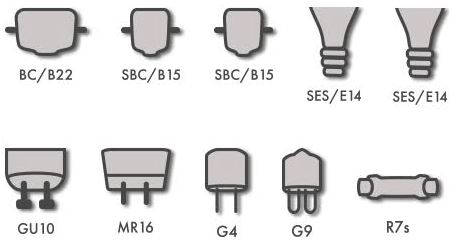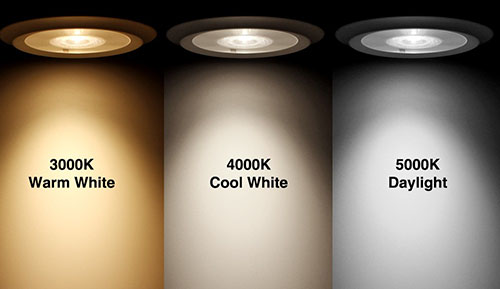LED Lamp Buying Guide
Lamps are changing and at a rapid pace. Traditional lamps are being phased out and replaced due to EU legislation and a demand for more energy efficient versions. With this rapid changing in technologies and options we have put together a quick guide to help you pick the perfect lamp for your application and explain the important features you should consider.

Lamps are changing and at a rapid pace. Traditional lamps are being phased out and replaced due to EU legislation and a demand for more energy efficient versions. With this rapid changing in technologies and options we have put together a quick guide to help you pick the perfect lamp for your application and explain the important features you should consider.
Lamp Shape and Base
If you are looking to replace your existing lamps with a LED equivalent you will need to know what base your current lamp has. For traditional light bulbs it will generally be a BC / B22 push in base or ES / E27 screw in. Ceiling spot lamps are generally either GU10 or the low voltage version MR16 pin base. We would suggest replacing MR16 LV lamps with GU10 lamp. You will need to disconnect the existing transformer and replace the lamp holder with the GU10 lamp holder.
The table below shows some of the common lamp bases.
If you are looking to replace your existing lamps with a LED equivalent you will need to know what base your current lamp has. For traditional light bulbs it will generally be a BC / B22 push in base or ES / E27 screw in. Ceiling spot lamps are generally either GU10 or the low voltage version MR16 pin base. We would suggest replacing MR16 LV lamps with GU10 lamp. You will need to disconnect the existing transformer and replace the lamp holder with the GU10 lamp holder.
The table below shows some of the common lamp bases.
Watts or Lumens?
Traditionally we purchase a lamp based on the wattage but wattage is a measure of energy usage and not brightness. LED lamps thankfully use a lot less wattage than traditional lamps which means they cost a lot less to run. Lumens is a unit of brightness so when replacing a lamp with a LED version we are more concerned with the lumen output of the LED lamp than the wattage. There are many LED lamps available online these days so buyers need to ensure what they purchase is fit for the application as many refer to being “equivalent to” 50W for example but their lumen value would suggest otherwise. The higher the lumen value for a lamp the brighter that lamp will be.
The values below offer a quick rule of thumb:

Traditionally we purchase a lamp based on the wattage but wattage is a measure of energy usage and not brightness. LED lamps thankfully use a lot less wattage than traditional lamps which means they cost a lot less to run. Lumens is a unit of brightness so when replacing a lamp with a LED version we are more concerned with the lumen output of the LED lamp than the wattage. There are many LED lamps available online these days so buyers need to ensure what they purchase is fit for the application as many refer to being “equivalent to” 50W for example but their lumen value would suggest otherwise. The higher the lumen value for a lamp the brighter that lamp will be.
The values below offer a quick rule of thumb:
- Replacing a 40W bulb you will need at least 450 lumens
- Replacing a 60W bulb you will need at least 800 lumens
- Replacing a 75W bulb you will need at least 1,100 lumens
- Replacing a 100W bulb you will need at least 1,600 lumens
Colour Temperature (CCT)
One very important factor to consider is the colour temperature of the lamp you want. Different colour temperatures will give alternative lighting effects. CCT or Correlated Colour Temperature defines the warmness or coolness of a lamps colour and is measured on the Kelvin scale.
Most of our LED lamps range from 2,700K (warm white) to 4,000K (cool white). LED tubes may have a CCT of 6,000 – 6,500K which would be close to natural daylight. The lower the colour temperature of the lamp the warmer the effect will be.
One very important factor to consider is the colour temperature of the lamp you want. Different colour temperatures will give alternative lighting effects. CCT or Correlated Colour Temperature defines the warmness or coolness of a lamps colour and is measured on the Kelvin scale.
Most of our LED lamps range from 2,700K (warm white) to 4,000K (cool white). LED tubes may have a CCT of 6,000 – 6,500K which would be close to natural daylight. The lower the colour temperature of the lamp the warmer the effect will be.

Dimmable or Not?
Not all LED lamps have dimming capability which is fine for most applications. However if you wish to use your LED lamps on a dimmer switch you will need to ensure that the lamp you purchase is dimmable. Look at the product features to see if the lamp is dimmable.
Some older existing light dimmers may need to have a LED dimmer module fitted if the load of the new LED lamps is not sufficient for the existing switch to work. If you find that your new LED dimmable lamp will not work with your dimmer switch please consult an electrician.
Not all LED lamps have dimming capability which is fine for most applications. However if you wish to use your LED lamps on a dimmer switch you will need to ensure that the lamp you purchase is dimmable. Look at the product features to see if the lamp is dimmable.
Some older existing light dimmers may need to have a LED dimmer module fitted if the load of the new LED lamps is not sufficient for the existing switch to work. If you find that your new LED dimmable lamp will not work with your dimmer switch please consult an electrician.







